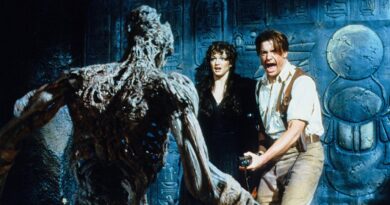Clue (1985)
Perhaps it’s only fitting that Clue was released with three different endings. The original board game, admittedly a favorite of mine, is known for its many possible solutions (I believe there are over 300) to the key questions of whodunit, in which room, with which weapon. And perhaps it’s just as well that Paramount Pictures saw the financial potential in this idea; if you shoot three separate endings to a comedic murder mystery, and if you make sure they each get screened at different theaters, you’ve ensured that completists will have to see the movie three times at three different locations. An evil marketing gimmick, to be sure. It’s also genius. There will always be those audiences, however small, willing to pay the extra money and drive the extra distances.
Should they go to the trouble? Not really; the endings labeled as A and B are appropriate enough, but the one labeled C is the most satisfying. All three have their strengths and weaknesses, the former mostly relating to cleverness and plotting, the latter evident in a few obvious continuity errors and an overall lack of plausibility. I could have overlooked this had it not been for the screenplay by director Jonathan Lynn, who greatly expands the scope of what Clue has traditionally been. Unlike the game, it’s not a simple matter of who killed Mr. Boddy, and the six suspects aren’t mere pawns with funny names; there are multiple murders, all with discernible motives, all related to convoluted connections between the main cast and several new characters.
The film is likely to be compared with Robert Moore’s Murder by Death. However, the only two things they have in common are the whodunit genre and being comedies. Murder by Death, written by Neil Simon, was an absurdist parody of murder-mystery tropes; the plot, the characters (spoofs of literary and cinematic detectives created by Agatha Christie, Earl Derr Biggers, and Dashiell Hammet), and any questions of who, how, and why were beside the point. Clue is silly, at times even slapstick, but a real mystery is part of a real story, and audiences are required to pay attention – even though the visual and verbal clues are in service of three different outcomes, which I suppose would make things very confusing.
In the tradition of classic whodunits (And Then There Were None immediately comes to mind), the six suspects – Colonel Mustard (Martin Mull), Professor Plum (Christopher Lloyd), Mr. Green (Michael McKean), Mrs. Peacock (Eileen Brennan, who was also in Murder by Death), Miss Scarlet (Lesley Ann Warren), and Mrs. White (Madeline Kahn) – are strangers who, in 1954 New England, have been invited by a butler (Tim Curry) to a dinner party at, of course, a sprawling gothic countryside manor. All of their names are assigned pseudonyms. All have embarrassing secrets related to their Washington D.C. political connections. And all are being blackmailed by a seventh guest, gangster Mr. Boddy (Lee Ving), who has somehow discovered their secrets.
After Mr. Boddy gifts each of the six guests one of the murder weapons made famous in the game – the candlestick, the rope, the lead pipe, the wrench, the knife, the revolver – things start going awry. That’s another way of saying that bodies start piling up. I won’t reveal specifically who gets murdered … but it’s no coincidence that several other characters are worked into the plot. There’s the Asian cook (Kellye Nakahara), who’s sadly given exactly one line of dialogue. There’s the French maid (Colleen Camp), portrayed less as an actual maid and more as a sexual fantasy, complete with a skimpy dress that intentionally flaunts her legs and ample bosom. Then we have a stranded motorist (Jeffrey Kramer), a cop (Bill Henderson), and a singing telegram girl (Jane Wiedlin), whose arrivals may not be as random as they seem.
So, the question is: Whodunit? Was it Professor Plum in the study with the lead pipe? Mrs. White in the ballroom with the candlestick? Did the butler do it? Or the maid? The answer depends on which ending you see. If you go the extra mile (perhaps literally) and see all three endings, I commend you for your stamina, your ability to find the necessary time, and your willingness to pay for three tickets. Setting aside the issue of the endings altogether, Clue is a fun movie. It’s more amusing than hilarious, and the plot is more complicated than it needs to be, but it’s entertaining nonetheless. I personally appreciated it as an homage to a genre that hasn’t entirely gone out of fashion but certainly isn’t as popular as it once was.
Note: The home video release of Clue includes all three endings. So if you missed the theatrical release, or if you went to just one showing during its run, you no longer have an excuse for not having seen them all.




